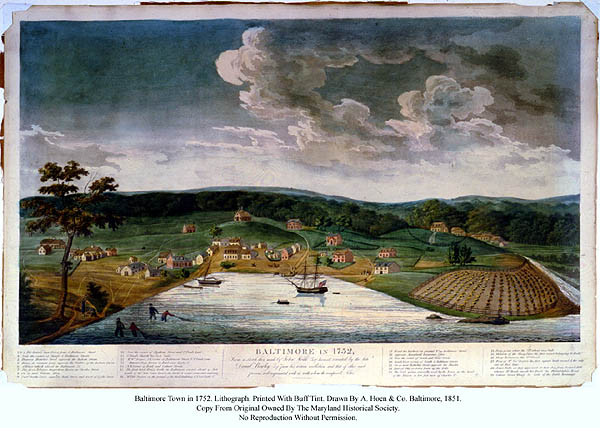Early American Colonial Life: Politics &
Economics

Baltimore Town in 1752 by John Moale
(Maryland Historical Society)
I. Mercantilist system
A. Colonies exist as a market for
home-country's goods and a supplier of raw materials
B. All trade with other nations needs to go through the home-country.
Series of Navigation Acts began in 1651
1. All trade had to be on English or
colonial ships
2. Enumerated products (tobacco, sugar, indigo, cotton, etc.) could be
shipped only to England or another English colony
3. Certain English-made goods (gunpowder, silk) were subsidized to
undercut European competitors
C. In general, the colonies prospered with the Navigation Acts
and cities like Philadelphia, New York, and Boston grew, though some
tobacco and rice planters complained
D. Some Americans viewed the mercantilist laws as excessive and were
sometimes ignored. James II responded by removing New England's charter
in 1688 and establishing the Dominion of New England, a royal province
that ignored previous land grants and outlawed town meetings.
II. Glorious Revolution of 1688
A. Fearing persecution, Protestants in Parliament carried out a
bloodless coup, fearing that James II would return England to
Catholicism.
1. James daughter Mary and her husband William of Orange were enthroned.
2. John Locke's Two Treatises on
Government argued that power flows from the consent of the
governed, not from God and that citizens have inalienable natural
rights (life, liberty, property)
3, Revolts in Massachusetts, Maryland, and New York asserted the right
of voluntary allegiance to the crown and self-government
4. England entered a period of salutary
neglect towards the colonies, effectively allowing the colonies
to grow in wealth, population, and self-government
III. Four Major Regions (Plantation South, Middle Colonies, New
England, and Frontier)
A. Plantation South
1. Tidewater region featured wide
coastal plain, wide rivers, and rich
soil particularly well-suited to tobacco farming.
a) Large plantations became
economically more successful as soil was
exhausted, leading to self-sufficing economic units.
b) As indentured servants became harder to obtain (and retain),
demand for slaves increased (400,000) in colonies by 1776
2. Only children of planters were
educated and higher education was
only for those who could afford it.
3. Plantation owners became the leading
economic, political, and
social forces of the South. Democracy limited to wealthy landowners.
B. Middle Colonies--farming,
manufacturing center
a). Dutch in Hudson Valley
b). Germans in Pennsylvania
c). Scotch-Irish in Pennsylvania
C. New England--rapid rivers and rocky
soil
1. 95% English immigrants, most from villages
2. Came in groups and settled in self-governing towns. New
England town meeting as center of power at first, but shifted to
selectmen in time.
3. Occupations included farming (scarce labor, tough
conditions), fishing, and commerce
a) Shipbuilding became major supplement to fishing and trad
b) Slavery, rum and the triangular trade with West Indies and
Africa brought economic wealth to New England
D. Backcountry/Frontier--continually
moving region: "The West."
1. Large families, exhausted soil encouraged westward movement
2. Religious dissenters, immigrants, and criminals all found
"refuge" in the West.
3. Vigorous spirit of democracy and emphasis on individual
freedom
a)Strenuous objection to any governmental interference in daily life
b) Anti-aristocratic tradition and resentment of urban areas
IV. Growth of Colonial Assemblies
A. Following the lead of the Whigs who
had established limits on the power of the crown with the Glorious
Revolution, American colonial assemblies sought to limit royal
authority and assert local control over
1) taxes
2) appointment of local officials
3) setting the governor's salary
B. In fact, the assemblies were elitist rather than democratic, with
rich men standing for office, though most property-owning men had the
right to vote.
C. Following the Glorious Revolution, mobs often exerted local control
in defiance of both the governor and the local assembly.
D. British policy of salutary neglect allowed local control to
grow as the crown focused on trade and military issues. Later, when the
British tried to re-assert the powers in mercantilist policies, they
found strong colonial resistnace.
Please cite this source when appropriate:
Feldmeth, Greg D. "Early American Colonies: Politics &
Economics," U.S. History Resources
http://home.earthlink.net/~gfeldmeth/USHistory.html (Revised 24 June
2004).
 Back to Outlines
& Charts Index
Back to Outlines
& Charts Index
 Back to U.S. History
Resources main page.
Back to U.S. History
Resources main page.


 Back to Outlines
& Charts Index
Back to Outlines
& Charts Index  Back to U.S. History
Resources main page.
Back to U.S. History
Resources main page.